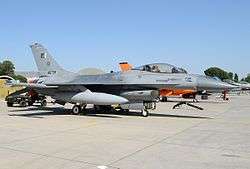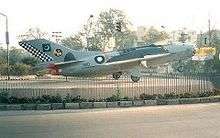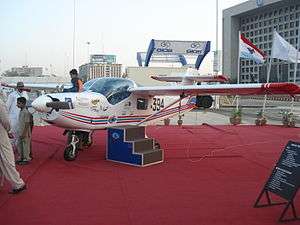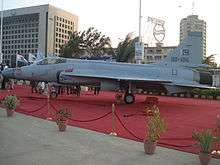Pakistan Aeronautical Complex
 Official logo of Pakistan Aeronautical Complex | |
| State-owned company | |
| Industry | |
| Founded | Kamra, Punjab, Pakistan 1971 |
| Headquarters | Kamra, Attock District, Punjab, Pakistan |
Area served | Worldwide |
Key people |
Air Mrshl Arshad Malik Chairman |
| Products |
Product list
|
Production output | Military Aircraft |
| Services |
Aircraft maintenance Aircraft MLU systems Aircraft design, R&D |
| Owner |
Ministry of Defence Production (Primary owner)(Other ownership) |
| Parent | Pakistan Air Force |
| Divisions |
Divisions
|
| Subsidiaries | Air Weapons Complex |
| Website | www.pac.org.pk |
The Pakistan Aeronautical Complex, (or PAC), is a Pakistani aerospace, defence, aviation contractor, and military corporation producing aerial systems for both military and civilian usage, situated in Kamra, Attock District.[1]
Founded in 1971 by the Pakistan Air Force (PAF), the PAC designs, develops, and build aircraft and avionics systems for the Inter–Services of the country; it also provides its services for civilian aircraft.[2] In addition, the PAC performs local maintenance and works on the aircraft MLU systems of foreign-built military and civilian aircraft. It is solely owned by the PAF as its corporate interests and its corporate appointments are directly made by the Chief of air staff from the Air HQ of the PAF.[2]
Mainly focusing on avionics, aviation, and high-tech electronics, the PAC also manufactures military systems for the Pakistan Army and Navy, which are listed as "valued customers".[3] Many of these products are specially suited for the Pakistan Armed Forces needs, while others are also marketed to foreign militaries. While it collaborated with several countries corporate organizations, the PAC often jointly works with the Turkish TAI and the Chinese CATIC.[4] Its aircraft's have been exported to Nigeria, Qatar, Saudi Arabia and United Arab Emirates.[5][6][7]
Operations

Since 1947, the Pakistan Air Force operated and dependent on foreign suppliers and the fighter jets and aircraft had to be sent abroad for desired inspection, development, and to produce parts to maintain the fighter aircraft in service, causing the downsizing of the air force.[1]
Consultation from the PAF's commanders at the AHQ at the Pindi Cantt and assistance from the Chinese government, the PAC was established in 1973 in Kamra with Aircraft Rebuild Factory first being functional.[8][9] The Pakistan Aeronautical Complex (PAC) was established by the Pakistan Air Force (PAF) as part of the new defence policy introduced in 1972; the PAC represents wide range of corporate revenue of the air force while fulfilling the national security needs of the country.[1] The Pakistan Aeronautical Complex started with three main Ministry of Defence projects designated P-721, P-741 and P-751.[8] The first two digits show the year of project approval and launch, the third digit is a serial designator.[8]
Since 1980s–90s, The PAC build licensed-built Mirage-III, Mirage-5, and the F-16s as well as building the F100 engines for the F-16s under licensed with the Pratt & Whitney.[10]

Aircraft Rebuild Factory
Aircraft Rebuild Factory (ARF), formerly known as F-6 Rebuild Factory(F-6RF) and P-721, is primarily dedicated to the overhaul and parts manufacture of Chinese aircraft in service with the Pakistan Air force (PAF). The factory is capable of overhauling and parts manufacturing for the Shenyang F-6 (now retired by the PAF), Nanchang A-5 (also retired by the PAF) and F-7 combat aircraft, as well as the Shenyang FT-5 and FT-6 jet trainer aircraft. ARF is also capable of manufacturing Drop Tanks and harnesses of aircraft.
Mirage Rebuild Factory
The Mirage Rebuild Factory (MRF), formerly known as P-741, is dedicated to the overhaul of French origin military aircraft in service with the Pakistan Air Force (PAF), the Dassault Mirage III and Mirage V combat aircraft. Overhaul and manufacturing services were utilized by other countries with French Mirage aircraft in service. The Mirage III ana Mirage 5 are under license and built at the PAC factory. This factory also grew to service and overhaul the Pratt & Whitney F100 turbofan engines belonging to the F-16 Fighting Falcon combat aircraft of the PAF.
Aircraft Manufacturing Factory

Aircraft Manufacturing Factory (AMF), formerly known as P-751, is dedicated to heavy military aircraft manufacturing. The MFI-17 Mushshak basic trainer aircraft built under license for use by the Pakistan Air Force (PAF) and Pakistan Army aviation wing. This factory project managed the aircraft modification and development venture that resulted in the MFI-395 Super Mushshak basic trainer, based on the MFI-17 Mushshak. Development of the K-8 Karakorum (also known as Hongdu JL-8) intermediate/advanced jet trainer was done in cooperation with Hongdu Aviation Industry Group of China, with AMF manufacturing parts for the aircraft. The JF-17 multi-role combat aircraft (also known as FC-1), a joint project between China and Pakistan, is now being manufactured by AMF. The MFI-17, MFI-395, K-8 and JF-17 are now in service with the (PAF). AMF also designs and manufactures unmanned aerial vehicles for uses such as target practice.
Manufacture of sub-assemblies for the JF-17 light-weight multi-role fighter began on 22 January 2008, while serial production of the fighter began on 30 June 2009.
On August 20, 2009 the PAF announced that it would begin production of its own unmanned aerial vehicles in collaboration with Italian company Selex Galileo. Production of the UAV, named Falco, was to begin soon.[11] An earlier opportunity to manufacture a fighter aircraft was lost when the Pakistan Air Force abandoned Project Sabre II in 1987, a joint effort by Pakistan, China and Grumman Aerospace that would have seen AMF manufacturing a re-designed Chengdu F-7 variant.
Avionics Production Factory (APF)
Avionics production Factory (APF), formerly known as Kamra Avionics and Radar Factory (KARF) was initiated as Radar Maintenance Centre (RMC) in 1983 to overhaul and rebuild ground-based radar systems. In 1989, RMC was expanded to become Kamra Radar & Avionics Factory (KARF). APF has the facilities to assemble and overhaul airborne as well as ground-based radar systems, electronics and avionics. Currently the only ISO 9002 certified facility among PAC, the factory was involved in upgrading the Pakistan Air Force (PAF) Chengdu F-7P interceptor fleet by replacing the original Italian built FIAR Grifo-7 radar with the more capable FIAR Grifo-7 mk-II radar, which was assembled under licence by APF. More recently, radar production involved the license assembly of the latest upgrade variant of the FIAR Grifo-7, the Grifo-7MG radar, which arms the Chengdu F-7PG combat aircraft of the PAF. In mid-2009 it was reported that APF personnel had completed training on printed circuit board assembly machines supplied by U.S. company APS Novastar, which would be used to make circuit boards for combat aircraft avionics.[12]
As PAC’s capabilities become competitive in the region, commercial ventures from national and international companies are also being undertaken.
Products
Aircraft
Aircraft parts
Aircraft maintenance components
- F-16 Fighting Falcon
- Dassault Mirage III
- Dassault Mirage V
- Chengdu F-7
- Shenyang F-6
- Nanchang A-5
- Lockheed C-130 Hercules
Unmanned aerial vehicles (UAV)
- Ubabeel Aerial Drone - A small arms target designed for target practice use by operators of small arms, machine guns. Also used to train operators for the larger and faster Baaz Aerial Drone. Can be very effective for recce missions.[13]
- Baaz Aerial Drone - A recoverable aerial target designed for use with air defence guns and surface-to-air missile (SAM) systems. It has a very high rate of accuracy[14]
- SELEX Galileo Falco - A surveillance UAV, production began in August 2009.[15][16]
Consumer Electronics
- The PAC also builds Android tablets PAC-PAD 1 and PAC-PAD Takhti7.[17]
- The PAC e-book 1[18]
- The PAC n-book 1[19]
References
- 1 2 3 "History of PAC". PAC. Retrieved 28 November 2014.
- 1 2 Introduction of PAC. "Introduction of PAC". Introduction of PAC. Retrieved 28 November 2014.
- ↑ "Customers of PAC". Customers of PAC. Retrieved 28 November 2014.
- ↑ PAC. "Collaboration". PAC collaboration. Retrieved 28 November 2014.
- ↑ "Nigeria to buy 10 Super Mushshak from Pakistan - The Express Tribune". The Express Tribune. 2016-10-22. Retrieved 2016-10-22.
- ↑ "Qatar to buy Super Mushshak - The Express Tribune". The Express Tribune. 2016-06-24. Retrieved 2016-10-22.
- ↑ "Pakistan Aeronautical Complex Kamra - Our Valued Customers". www.pac.org.pk. Retrieved 2016-10-22.
- 1 2 3 Singh, RSN (2005). Asian strategic and military perspective. New Delhi: Lancer Publishers & Distributors. ISBN 817062245X. Retrieved 23 December 2014.
- ↑ Singh, R.S.N. (2008). The military factor in Pakistan. New Delhi: Frankfort, IL. ISBN 0981537898. Retrieved 23 December 2014.
- ↑ Staff writer. "MIRAGE REBUILD FACTORY". MIRAGE REBUILD FACTORY. Retrieved 23 December 2014.
- ↑ Malik, Sajjad (2009-08-21). "Pak version of drones 'whirrs' into production". Daily Times. Retrieved 2009-08-21.
- ↑ http://www.macalliance.com/APS%20Novastar%20on%20a%20circuit%20in%20Pakistan.pdf
- ↑ Archived May 14, 2009, at the Wayback Machine.
- ↑ Archived May 14, 2009, at the Wayback Machine.
- ↑ "Pakistan Air Force Begins Production of Falco UAV". Airforce Technology. Retrieved 2013-05-03.
- ↑ "Pakistan to begin co-production of Falco UAV". Flightglobal.com. 2009-08-26. Retrieved 2013-05-03.
- ↑ Brummitt, Chris. "Guns and Androids: Pakistan Air Force Making iPads." Associated Press. February 17, 2012.
- ↑ http://www.cpmc.pk/products/pac-ebook-1/
- ↑ http://www.cpmc.pk/products/pac-nbook-1/

